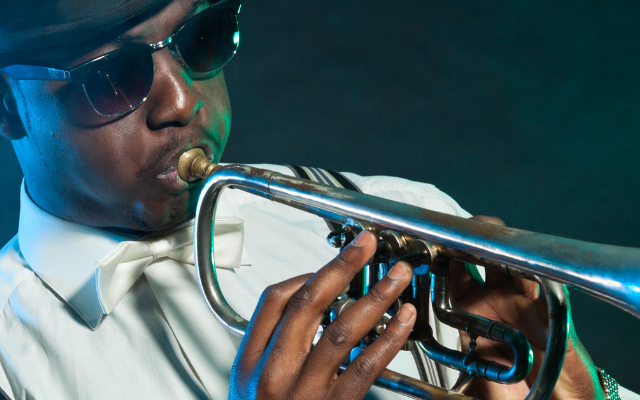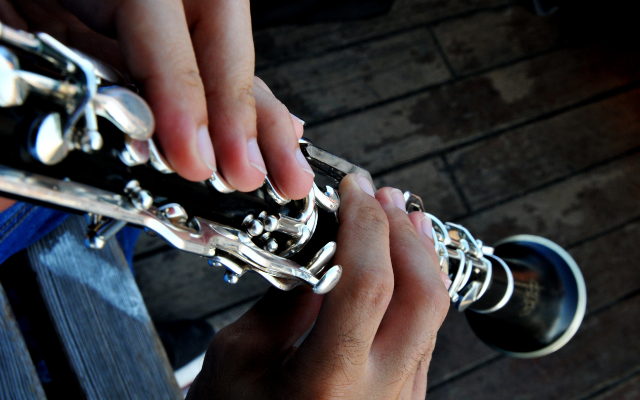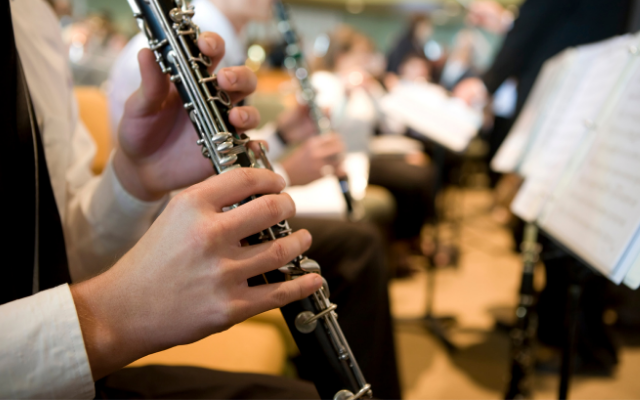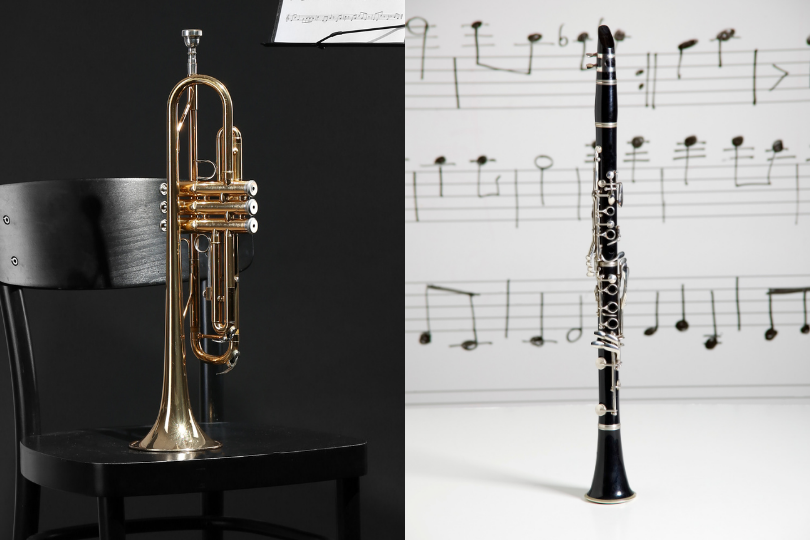The trumpet and the clarinet are both amazing instruments with distinct and beautiful sounds. While the trumpet has a great presence in many styles of music, the clarinet stands out in bands and orchestras with its fast and warm tones.
If you’re looking to learn a new instrument, you may be torn between the two. Should you choose the trumpet or the clarinet?
Many learners feel clarinet is easier to learn than trumpet because each note can be mapped to a single fingering, unlike the trumpet, and no buzzing is involved being a reed instrument. The trumpet is more physically demanding, namely on the lungs, and relies heavily on lip muscle memory for pitch.
In trying to choose between the trumpet and clarinet, you need to consider not the challenges of embouchure, breath, and fingerings, as well the type of musical setting you’re aiming for, the cost of the instruments, and the practicality of each.
Table of Contents
Trumpet or clarinet: embouchure

If you compare the trumpet with the clarinet, the embouchure (how you use the muscles of your mouth to play a wind instrument) is quite different.
For the trumpet, you buzz your lips while blowing into the mouthpiece. This buzzing creates the vibration which makes the sound.
The firmness of the trumpet embouchure changes depending on what note you want to play. On the trumpet, more of the work comes from the lips than the fingers.
On the clarinet, sound is created by blowing air between a single reed and a mouthpiece. You put your lower lip over your teeth, your top teeth on the mouthpiece and close your lips to make a seal.
This firm embouchure basically stays the same. More of the fingers are used to play the different notes.
There are drawbacks in the embouchure for both instruments. For trumpet, it’s easy to get chapped lips and pressing the mouthpiece to the lips can eventually become painful because it cuts off the circulation to the lips.
For clarinet, there is pressure between the mouthpiece and the lower teeth pushing against the lower lip. Your teeth can cut into your lower lip, which is painful.
Trumpet or clarinet: breath and pitch
The trumpet and the clarinet both require good breath support. For both, you need to fill the instrument with fast-moving air to get a good sound.
On the trumpet, you change pitch partly by adjusting the tightness of your lips. You need to adjust the firmness of your embouchure to make these changes, which involve hitting different partials or overtones.
So you rely on your lip position and air speed to play the correct pitches with the correct sound. A big challenge on the trumpet is playing in the higher range. It takes practice and time to succeed at playing the high notes.
On the clarinet, you only make slight adjustments for changes of intonation and when playing high notes, but maintain a firm embouchure throughout. Eventually, you build up the endurance to hold the embouchure steady.
Trumpet or clarinet: fingerings

When it comes to fingering, pressing valves on the trumpet is very different from covering holes and pressing the many levers on the clarinet.
On the trumpet, you press three valves, while on the clarinet, you open and close holes and keys. On the clarinet, you use nine fingers to change pitch, vs only three fingers of one hand for the trumpet.
With the trumpet’s three valves, it takes a while to learn and memorize the different combinations of fingers to press down for each note. Each valve can have five combination possibilities. The trumpet has a range of about three octaves.
Fingerings are much more varied on the clarinet. Your right thumb holds the weight of the instrument, while the remaining fingers open and close holes to produce the different notes.
On the clarinet, a single finger may be responsible for operating up to five different holes and keys, so you need good finger dexterity. The clarinet has a bigger range than the trumpet, about four octaves, with many different fingerings to learn.
The clarinet being an open hole instrument is also a challenge. The player needs to learn to completely cover the holes and this can be tricky for young players with little fingers.
Switching from clarinet to trumpet
Since the two instruments are so different in how they are played, switching from one to the other can be rather difficult.
For the clarinet player who wants to play trumpet, the most obvious challenge is the difference in embouchure.
A clarinet player would first need to get used to buzzing into the mouthpiece. S/he might start with the mouthpiece alone as if it’s the entire trumpet.
By practicing siren calls, scales and arpeggios, the clarinet player can begin to develop a flexible embouchure.
Once s/he is ready to play with the mouthpiece attached to the trumpet, the clarinet player would work on making the embouchure adjustments needed to create different pitches.
A clarinet player probably wouldn’t have trouble transposing for the trumpet because both instruments are pitched in Bb.
Clarinet or trumpet for different types of music

Both the trumpet and the clarinet are able to play a wide variety of styles. The trumpet is more commonly found in jazz ensembles.
Jazz clarinet is popular for Dixieland style jazz, though saxophone is more prevalent in other styles. That’s why many jazz clarinetists also play saxophone.
For marching band, trumpet players usually like the fact that they can be heard more easily than clarinet players. They are often given soprano or alto solos to play because the trumpet sound is louder and projects better.
In contrast, you often see a large group of clarinets playing in order to build up their volume.
For solo, orchestra or band music, the clarinet is often given the soprano melody, with fast moving parts and sixteenth note patterns extending through the range of the instrument.
This type of music is easier to accomplish on the clarinet and it’s fun to do.
Clarinet vs. trumpet cost
The price of the equipment is an important consideration when deciding whether to learn the trumpet or the clarinet.
Beginner clarinets and beginner trumpets are basically in the same price range. For both, cheap instruments are available on the market but it’s very important to get a quality instrument..
| Beginner Trumpets | |
| Bach TR300H | $700 |
| Jupiter JTR700 | $699 |
| Yamaha YTR-2330 | $820 |
| Beginner Clarinets | |
| Buffet Crampon Premium Bb Clarinet | $700 |
| Conn-Selmer Prelude | $440 |
| Yamaha YCL 255 | $1,100 |
One good option is looking for a used beginner instrument. Websites like reverb.com and ebay.com usually have many to choose from.
Your band director can guide you to instruments that are in good playing condition. You don’t want to purchase an instrument and then have to pay extra for repairs before it will even play.
For the clarinet, reeds add to the cost. A reed is a piece of cane which attaches to the mouthpiece to produce the sound. Reeds need to be replaced periodically. A box of 10 reeds typically cost between $19 and $33.
A beginner trumpet player may need a straight mute, which starts at about $20.
The trumpet and the clarinet should be handled with care to be sure they continue to play properly. Even so, sometimes they will need repair due to daily wear and tear.
For clarinet, a pad may come out or a spring may move out of position. For trumpet, the mouthpiece may get stuck.
For these types of repairs, your band director may be able to help. If not, you’ll need to take your instrument to a music repair shop. Small repairs often cost around $20.
Clarinet vs. trumpet practice
One major drawback to practicing the trumpet is sound level. Because it plays much louder than the clarinet, it can easily disturb family members and neighbors. A practice mutes may help somewhat alleviate this problem.
Setting up for practicing the clarinet requires more work as you need to assemble and disassemble the instrument. There are five separate sections to put together and correctly align.
You also need to carefully place the reed between the mouthpiece and the ligature, which holds the reed on. When finished practicing, you need to put the reed away in its case and dry out the clarinet sections with a swab before storing them.
See this post for more about leaving a clarinet assembled.

